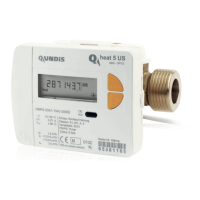Operating and
Installation Instructions
Ultrasonic heat and cold meter
Q heat 5.5 US – comp.
Note: In the text below, the term meter refers both to
the heat meter and to the cooling meter and the com-
bined heat and cooling meter, unless otherwise speci-
fied.
1. General
1.1 Use
The meter is used for heating or cooling consumption meas-
urement in systems with water.
The meter consists of a high-tech plastic volume measurement
unit, two temperature sensors connected in a fixed position and
an electronic unit that calculates the energy consumption from
the volume and temperature difference.
The meter combines modern microcomputer technology with
innovative ultrasonic measuring technology for which no me-
chanically moving parts are necessary.
This technology is thus wear free, robust and largely mainte-
nance free. High precision and long-term stability guarantee
precise and equitable cost accounts.
Note: The meter cannot be opened without damaging
the security seal.
1.2 General notes
The meter left the factory in a faultless condition where safety
is concerned. The manufacturer will provide additional tech-
nical support on request. Calibration relevant security seals on
the meter must not be damaged or removed. Otherwise, the
warranty and calibration validity of the meter will no longer
apply.
• Keep the packaging so that you can transport the meter in
its original packaging following expiry of the calibration va-
lidity.
• Lay all cables at a minimum distance of 500 mm to high
voltage and high frequency cables.
• A relative humidity of <93% at 25 °C is permissible (without
condensation).
• Avoid cavitation in the whole system due to overpressure
i.e. at least 1 bar at qp and approx. 2 bar at qs (applies for
approx. 80 °C).
2. Safety Information
The meters may only be used in building service
engineering plants and only for the applications de-
scribed.
The local regulations (installation etc.) must be ad-
hered to.
The operating conditions according to the type plate
must be complied with during use. Non-compliance
can result in hazardous situations and the expiry of all
claims arising from liability for defects as well as liabil-
ity on the basis of any expressly granted guarantees.
Do not under any circumstances carrying out welding,
drilling or soldering work close to the meter.
The meter is only suitable for circulating water in
heating systems.
The meter is not suitable for drinking water.
Requirements for circulating water (CEN / TR 16911:
2016).
Only personnel, trained in the installation and opera-
tion of meters in heating and cooling systems, may
install and remove the meter.
Only install or remove the meter when the pipes are
pressure-less.
After installing the meter, check the leak-tightness of
the system.
Warranty and calibration validity will lapse if the cali-
bration relevant security seal is broken.
Only clean the meter from outside with a soft, lightly
wetted cloth. Do not use any spirit or cleaning solvent.
As far as disposal is concerned, the meter is a waste
electronic appliance in the sense of European Di-
rective 2012/19/EU (WEEE) and it must not be dis-
posed of as domestic waste.
The meter contains lithium batteries. Do not dispose of
the meter and the batteries with domestic waste.
Observe the local stipulations and laws on disposal.
You can return the lithium batteries to the manufactur-
er for appropriate disposal following use. When ship-
ping please observe legal regulations, in particular,
those governing the labelling and packaging of haz-
ardous goods.
Do not open the batteries. Do not bring batteries into
contact with water or expose to temperatures above
80 °C.
The meter does not have any lightning protection.
Ensure lightning protection via the in-house installa-
tion.
3. Installation
To install the meter proceed as follows:
• Determine the place of installation in line with the inscrip-
tion on the meter.
Note: At a heating meter or combined
heat/cold meter the mounting place of the flow sen-
sor cold side is equivalent to return . The
mounting place of the flow sensor hot side is equiva-
lent to flow .
Note: At a cooling meter the mounting place
of the flow sensor hot side is equivalent to the return
. The mounting place of the flow sensor cold
side is equivalent to flow .
Note: At a meter with an adjustable mounting
place , the mounting place hot side is displayed
as . The mounting place cold side is dis-
played as .
• Observe the dimensions of the meter and check whether
there is sufficient space available. Rinse the system thor-
oughly before installing the meter.

